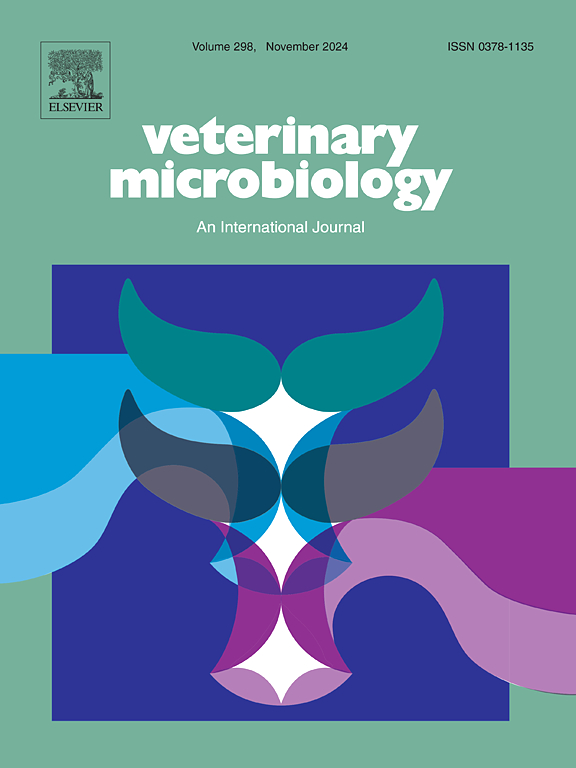一株韩国nadc34样猪繁殖与呼吸综合征病毒株对怀孕母猪的致病性评价
IF 2.7
2区 农林科学
Q3 MICROBIOLOGY
引用次数: 0
摘要
猪繁殖与呼吸综合征病毒(PRRSV)仍然是猪繁殖失败的主要原因,新出现的nadc34样毒株由于其毒性增强和与晚期流产有关而引起越来越多的关注。在这项研究中,我们评估了韩国nadc34样分离物SNUVP231106在8只无prrsv的妊娠母猪中的致病性。受感染的动物表现出发烧、厌食、嗜睡,尽管没有明显的呼吸体征,但有一例需要安乐死。与对照组相比,血清TNF-α和IFN-α水平显著升高。所有4只接种过疫苗的母猪在妊娠第110-112天早产,所有51个胎儿都是死产,包括自溶、腐烂和干尸形式。实时荧光定量pcr证实dpi 4-7与dpi 7血清转化之间存在病毒血症。值得注意的是,在67 %的胎儿血清和95 %的胸腺样本中检测到PRRSV RNA,胸腺中的病毒载量更高。虽然组织病理学变化不明显,但通过免疫组化在胸腺巨噬细胞中检测到PRRSV抗原。韩国nadc34样毒株SNUVP231106在本研究中显示可引起妊娠后备母猪严重的全身疾病和生殖衰竭。这些发现将有助于制定针对nadc34样毒株的诊断和预防策略,并可能针对其他高毒力PRRSV变体。本文章由计算机程序翻译,如有差异,请以英文原文为准。
Evaluation of pathogenicity of a Korean NADC34-like Porcine reproductive and respiratory syndrome virus strain in pregnant gilts
Porcine reproductive and respiratory syndrome virus (PRRSV) remains a major cause of reproductive failure in swine, with emerging NADC34-like strains drawing increasing attention due to their enhanced virulence and association with late-term abortion. In this study, we evaluated the pathogenicity of a Korean NADC34-like isolate, SNUVP231106, in eight PRRSV-free pregnant gilts. Infected animals exhibited fever, anorexia, lethargy, and one case requiring euthanasia, despite the absence of prominent respiratory signs. Serum TNF-α and IFN-α levels were significantly elevated compared with the control group. All four inoculated gilts delivered prematurely at gestation days 110–112, and all 51 fetuses were stillborn, including autolytic, decomposed, and mummified forms. Real-time qPCR confirmed viremia between dpi 4–7 and seroconversion by dpi 7. Notably, PRRSV RNA was detected in 67 % of fetal serum and 95 % of thymus samples, with higher viral loads in the thymus. Although histopathological changes were not apparent, PRRSV antigens were detected in thymic macrophages via IHC. The Korean NADC34-like strain SNUVP231106 was shown in this study to cause severe systemic illness and reproductive failure in pregnant gilts. These findings will contribute to the development of diagnostic and preventive strategies for NADC34-like strains, and potentially for other highly virulent PRRSV variants.
求助全文
通过发布文献求助,成功后即可免费获取论文全文。
去求助
来源期刊

Veterinary microbiology
农林科学-兽医学
CiteScore
5.90
自引率
6.10%
发文量
221
审稿时长
52 days
期刊介绍:
Veterinary Microbiology is concerned with microbial (bacterial, fungal, viral) diseases of domesticated vertebrate animals (livestock, companion animals, fur-bearing animals, game, poultry, fish) that supply food, other useful products or companionship. In addition, Microbial diseases of wild animals living in captivity, or as members of the feral fauna will also be considered if the infections are of interest because of their interrelation with humans (zoonoses) and/or domestic animals. Studies of antimicrobial resistance are also included, provided that the results represent a substantial advance in knowledge. Authors are strongly encouraged to read - prior to submission - the Editorials (''Scope or cope'' and ''Scope or cope II'') published previously in the journal. The Editors reserve the right to suggest submission to another journal for those papers which they feel would be more appropriate for consideration by that journal.
Original research papers of high quality and novelty on aspects of control, host response, molecular biology, pathogenesis, prevention, and treatment of microbial diseases of animals are published. Papers dealing primarily with immunology, epidemiology, molecular biology and antiviral or microbial agents will only be considered if they demonstrate a clear impact on a disease. Papers focusing solely on diagnostic techniques (such as another PCR protocol or ELISA) will not be published - focus should be on a microorganism and not on a particular technique. Papers only reporting microbial sequences, transcriptomics data, or proteomics data will not be considered unless the results represent a substantial advance in knowledge.
Drug trial papers will be considered if they have general application or significance. Papers on the identification of microorganisms will also be considered, but detailed taxonomic studies do not fall within the scope of the journal. Case reports will not be published, unless they have general application or contain novel aspects. Papers of geographically limited interest, which repeat what had been established elsewhere will not be considered. The readership of the journal is global.
 求助内容:
求助内容: 应助结果提醒方式:
应助结果提醒方式:


